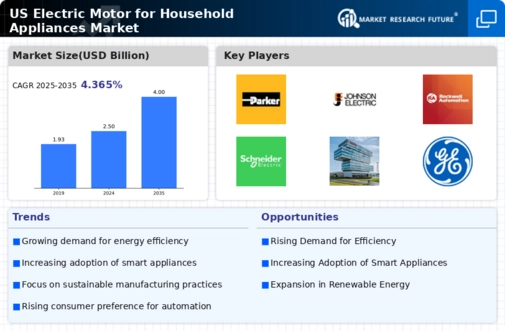The US Electric Motor for Household Appliances Market is characterized by a diverse array of players and a dynamic competitive landscape. With the increased emphasis on energy efficiency and technological advancements in household appliances, this sector has witnessed sustained growth. Companies operating within this market are striving to innovate and capitalize on evolving consumer preferences, leading to a heightened focus on product development and operational efficiency. The competition revolves around offering high-performance electric motors that align with consumer demand for sustainable and efficient solutions, leading to robust strategies aimed at maintaining and enhancing market share.
Moreover, the landscape is marked by ongoing investments in research and development, as well as strategic partnerships and collaborations to leverage synergies and improve product offerings.Danaher Corporation stands as a notable entity in the US Electric Motor for Household Appliances Market, benefitting from its strong commitment to innovation and a diverse product portfolio. The company has established a significant market presence through its advanced technologies, which provide unique solutions tailored for various household applications. Danaher Corporation's strengths lie in its capability to integrate intelligent systems that optimize performance and enhance user experience while ensuring energy efficiency.
With a robust framework for research and development, the company is positioned to continuously improve its electric motor technologies. Such strengths have facilitated Danaher Corporation in maintaining a competitive edge in the electric motor segment, especially in the realm of household appliances, where performance and reliability are paramount to consumer decision-making.Emerson Electric is another key player in the US Electric Motor for Household Appliances Market, recognized for its comprehensive range of electric motor solutions. The company’s key offerings include high-efficiency motors, precision components, and smart technologies that cater to the demands of modern household appliances.
Emerson Electric has a solid market presence, attributed to its focus on innovation, sustainability, and operational excellence. The company has strategically engaged in mergers and acquisitions to enhance its market position and expand its product portfolio. This approach has allowed Emerson Electric to integrate new technologies and improve its capabilities in delivering tailored solutions for household appliances. Furthermore, the company emphasizes enhancing energy efficiency and performance in its products, making them appealing to eco-conscious consumers. Its ongoing commitment to improving household appliance solutions solidifies its stature as a formidable competitor in the electric motor market in the US.



















Leave a Comment